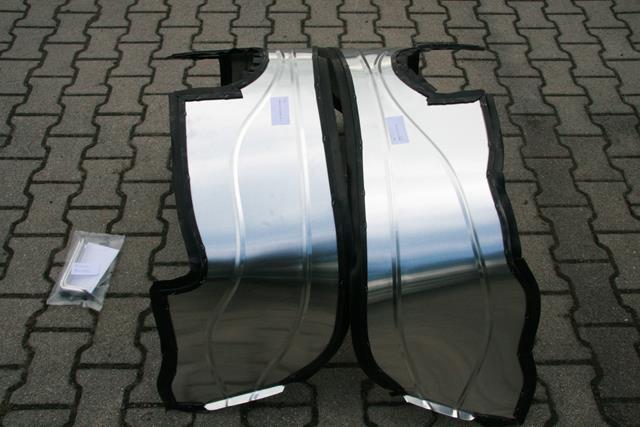New member @jgprice brought up front fender rust in his introduction this summer. It inspired me to share some images for coupe owners who haven't learned about this the hard way (or the smart way - from someone else's experience!)
Problem - Rusty Front Fender Tops: I can relate to John's choice of words for the front fenders under his hood, specifically their "dissolving" condition! Mine were mostly dissolved before restoration. During restoration, I found that every spot that rusted completely through in my coupe seemed to have a rust accelerator. The biggest one was mud/dirt packed into cavities. Whomever designed the inner fender sheet metal must have had no idea that they had created a perfect mud trough at the top of the wheel well that would infect nearly all our cars with rust. You can only get to it from underneath with the wheel off. The opening points away from the engine bay and is hard to ascertain, but to make matters worse, the metal takes a step down to make a literal trough shape perfect for holding lots of wet mud! The first attached photo speaks volumes. Another coupe owner told me how he had drilled a series of sizable "drain" holes in the bottom of the "trough" and I chose to do the same to mine in the name of preservation. You can imagine how all that dirt would retain water and take forever to dry while your fenders are dissolving the entire time!
Conclusions: Rust is definitely the enemy of these cars. As owners, maintenance and prevention are key. Hopefully, no coupe owner will ever allow their car to be driven on a wet/muddy dirt road! If it is, take it straight to a lift with a pressure washer, remove the wheels, put on your poncho, safety glasses and get it clean... or invent a time machine to go back in time to not allow it to be driven on muddy roads, ever ;-)! Also, you could consider drilling your "under" fenders: 1. To see if they are packed with mud already. 2. To have places for dirt & water to drain while driving in wet conditions. 3. To have more places for you to access with a pressure washer if your ever need to! I drilled several .375" (9.5 mm) holes, spaced every 3" (75 mm) in the left and right wheel well, basically through the steel under where all the dirt is in the 1st photo below. I drilled from underneath, it doesn't show from above. The holes are shown in photos 5 & 6 below, (after media blasting, prior to restoration).






Problem - Rusty Front Fender Tops: I can relate to John's choice of words for the front fenders under his hood, specifically their "dissolving" condition! Mine were mostly dissolved before restoration. During restoration, I found that every spot that rusted completely through in my coupe seemed to have a rust accelerator. The biggest one was mud/dirt packed into cavities. Whomever designed the inner fender sheet metal must have had no idea that they had created a perfect mud trough at the top of the wheel well that would infect nearly all our cars with rust. You can only get to it from underneath with the wheel off. The opening points away from the engine bay and is hard to ascertain, but to make matters worse, the metal takes a step down to make a literal trough shape perfect for holding lots of wet mud! The first attached photo speaks volumes. Another coupe owner told me how he had drilled a series of sizable "drain" holes in the bottom of the "trough" and I chose to do the same to mine in the name of preservation. You can imagine how all that dirt would retain water and take forever to dry while your fenders are dissolving the entire time!
Conclusions: Rust is definitely the enemy of these cars. As owners, maintenance and prevention are key. Hopefully, no coupe owner will ever allow their car to be driven on a wet/muddy dirt road! If it is, take it straight to a lift with a pressure washer, remove the wheels, put on your poncho, safety glasses and get it clean... or invent a time machine to go back in time to not allow it to be driven on muddy roads, ever ;-)! Also, you could consider drilling your "under" fenders: 1. To see if they are packed with mud already. 2. To have places for dirt & water to drain while driving in wet conditions. 3. To have more places for you to access with a pressure washer if your ever need to! I drilled several .375" (9.5 mm) holes, spaced every 3" (75 mm) in the left and right wheel well, basically through the steel under where all the dirt is in the 1st photo below. I drilled from underneath, it doesn't show from above. The holes are shown in photos 5 & 6 below, (after media blasting, prior to restoration).

